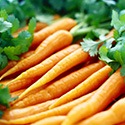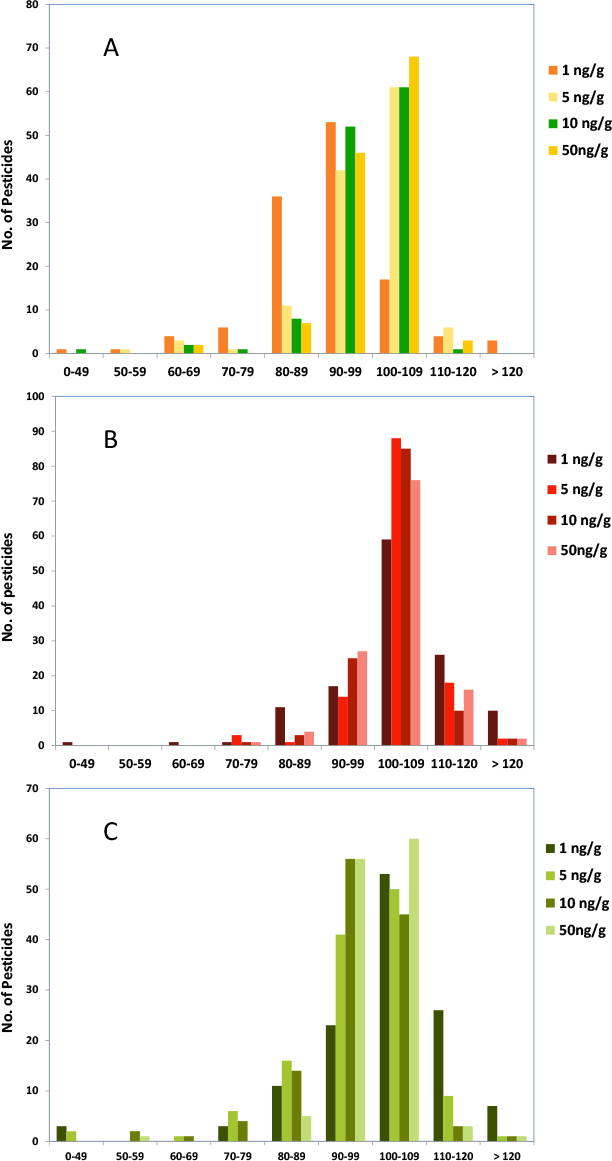Access Agilent eNewsletter May 2016

Agilent Mini-QuEChERS and HES provide robustness and cost-savings in GC/MS/MS pesticide analysis of foods
Melissa Churley and Joan Stevens, Agilent Senior Applications Scientists
Improved sample preparation remains a priority for reliable analysis of pesticides residues in foods. The Agilent QuEChERS extraction method is widely used, but many labs experience cost pressures and would like a less expensive version of this popular technique. In response, Agilent has developed a miniaturized sample preparation version of QuEChERS (Mini-QuEChERS) in which the quantities of sample, solvent, and salts are proportionately reduced in order to maintain the ratio of sample to solvent to salt documented within the original QuEChERS method.
The high-efficiency source (HES) of the Agilent 7010 Series Triple Quadrupole GC/MS represents a revolution in ion source design with greatly enhanced sensitivity. The HES increases the number of ions that are created in the source and transferred into the quadrupole analyzer. More ions deliver greater signal, which leads to better sensitivity. In the case of pesticides residues analysis in foods, a practical benefit is that reduced injection volumes, such as 0.5 µL instead of 2 µL, may be used while still achieving the required detection limits.
Advantages of miniaturized sample preparation include:
- Reduced solvent cost and waste
- Smaller sample sizes that are easier to handle, store, and process in the lab
- Sample preparation sorbent and labeled compounds used as internal standards are cost-effective
- Smaller sample sizes allow you to use additional labeled compounds for troublesome analytes—compounds that are cost-prohibitive with larger sample sizes
Improve robustness, lower injection volumes, and reduce maintenance
Food sample analysis using the high-efficiency source of the Agilent 7010 Triple Quadrupole GC/MS, in combination with the scaled-down QuEChERS extraction method, results in substantial cost savings associated with sample preparation, improved robustness of the analytical method due to reduced injection volumes, and less frequent instrument maintenance. Additional internal standards, such as deuterated captan and folpet, could be included without significant cost increase per sample, thus improving routine analysis for these challenging, base-sensitive compounds.

Figure 1. Distribution of average recoveries for 126 pesticides spiked at 1, 5, 10, and 50 ng/g in carrot (A), tomato (B), and celery (C).
Cut costs while meeting detection limits
To demonstrate analysis efficiency (Figure 1), we extracted carrot, tomato, and celery using Mini-QuEChERS and achieved cost savings of more than 40% due to reductions in solvent, sorbent, and labeled internal standards (ISTDs). Calibration standards prepared in matrix at concentrations of 1, 5, 10, and 50 ng/g yielded correlation coefficient (R2) values that were ≥0.992 for 97% of the 126 pesticides used to fortify the carrot, tomato, and celery matrixes. In the three matrixes, recovery-based LOQs for 86-90% of the 126 pesticides analyzed were 1 ng/g, and 95-98% of the pesticides had LOQs ≤ 5 ng/g, which is half the accepted default maximum residue limit (MRL) of 10 ng/g. We quantified the challenging captan and folpet residues at ≤5 ng/g and 1 ng/g, respectively. To do this, we employed the commercially available ISTDs captan-d6 and folpet-d4 for only $0.04 per sample.
Get better analysis results with an inert flow path
To further improve our analysis, we maximized flow path inertness by using Agilent J&W HP-5ms Ultra Inert GC columns (5 m x 0.25 mm, 0.25 µm and 15 m x 0.25 mm, 0.25 µm), Agilent Ultra Inert 2 mm dimpled liner, and Agilent UltiMetal Plus Flexible Metal ferrules at the Agilent Purged Ultimate Union used to backflush the column.
Inject 75% less sample with a high-efficiency source
Table 1 shows a list of some challenging pesticides monitored in carrot, tomato, and celery. The robust HES reduced injection volumes by 75%.
| Carrot | Tomato | Celery | |
|---|---|---|---|
| Bifenthrin | 1 | 1 | 1 |
| Bupirimate | 1 | 1 | 1 |
| Captan | 5 | 5 | 1 |
| Chlorothalonil | 1 | 1 | 1 |
| Chlorpropham | 1 | 1 | 1 |
| Clomazone | 1 | 1 | 1 |
| Cypermethrin | 1 | 1 | 1 |
| Cyprodinil | 1 | 5 | 1 |
| Diazinon Results | 1 | 1 | 1 |
| Dicloran | 1 | 1 | 1 |
| Dieldrin | 1 | 1 | 1 |
| Difenoconazole I | 1 | 1 | 1 |
| Diphenylamine | 1 | 1 | 1 |
| Endosulfan I | 5 | 1 | 1 |
| Endosulfan II | 1 | 1 | 1 |
| Endosulfan Sulfate | 1 | 1 | 1 |
| Endrin | 1 | 1 | 1 |
| Etridiazole | 1 | 1 | 5 |
| Fenpropathrin | 1 | 1 | 1 |
| Fenvalerate | 1 | 1 | 1 |
| Fludioxonil | 1 | 1 | 1 |
| Folpet | 1 | 1 | 1 |
| Fuberidazole | 5 | 5 | 1 |
| Iprodione | 1 | 1 | 1 |
| Lenacil | 1 | 1 | 1 |
| Lindane (gamma-BHC) | 1 | 1 | 5 |
| Linuron | 1 | 1 | 5 |
| Metalaxyl | 1 | 1 | 1 |
| Methoxychlor-p,p | 1 | 1 | 1 |
| Nuarimol | 1 | 1 | 1 |
| Parathion-ethyl | 1 | 1 | 1 |
| Penconazole | 1 | 1 | 1 |
| Pendimethalin | 1 | 1 | 1 |
| Permethrin I | 1 | 5 | 5 |
| Permethrin II | 1 | 1 | 1 |
| Pirimicarb | 1 | 1 | 1 |
| Pirimiphos-methyl | 1 | 1 | 1 |
| Prochloraz | 1 | 1 | 1 |
| Pyridaben | 1 | 1 | 5 |
| Pyriproxyfen | 1 | 1 | 1 |
| Quinalphos | 1 | 1 | 1 |
| Secbumeton | 1 | 1 | 1 |
| Tebuconazole | 1 | 1 | 1 |
| Terbuthylazine | 1 | 1 | 1 |
| Tetrachlorvinphos, E-isomer | 1 | 1 | 5 |
| Tetraconazole | 1 | 1 | 1 |
| THPI | 1 | 5 | 1 |
| Triadimefon | 1 | 1 | 1 |
| Triadimenol | 1 | 1 | 1 |
| Trifluralin | 1 | 1 | 1 |
Table 1. A partial list of recovery-based LOQs for some challenging pesticides monitored in carrot, tomato, and celery (ng/g). Average recovery (n=6) was between 70% and 120% and percent relative standard deviations (%RSDs) were ≤ 20. Injection volumes reduced by 75%, i.e. 0.5 µL injected, allowed for quantitation at 1 ng/g.
Mini-QuEChERS reduces sample prep costs by 43 to 48%
As shown in Table 2, Agilent Mini-QuEChERS reduces costs by 43 to 48% per sample, depending on the type of dispersive clean-up used.
| Sample Preparation Cost/Sample | Centrifuge Tube | ACN | Salts | Internal Standards: Captan-d6, Folpet-d4 | dSPE General F&V or Universal | Total Cost/Sample | Cost Savings |
|---|---|---|---|---|---|---|---|
| QuEChERS | $0.43 | $1.50 | $2.96 | $0.30 | $1.32/$1.96 | $6.51/$7.15 | - |
| Mini-QuEChERS | $0.42 | $0.20 | $0.80 | $0.04 | $1.32/$1.96 | $2.78/$3.42 | 43%/48% |
Table 2. Cost breakdown for sample preparation with QuEChERS and Mini-QuEChERS techniques.
Save time and money with Agilent Mini-QuEChERS and HES
With Agilent Mini-QuEChERS, scaled-down sample preparation and decreased instrument maintenance result in significantly lower costs. This is made possible by use of a miniaturized method and a high-efficiency source for GC/MS/MS analysis. You can achieve low LOQs of 1 ng/g for 86-90% of pesticides spiked into carrot, tomato, and celery—despite injecting 75% less sample to improve ruggedness of the overall method.
To learn more about the use of QuEChERS for food safety, explore a free Applications Notebook. Then adopt miniaturized QuEChERS to reduce costs in your busy lab.
Agilent offers a broad array of solutions for food safety
Detecting pesticides in food products can be most challenging. Due to the wide range of samples and preparation approaches, technicians need methods that provide multiple results from a single extract injection. Agilent’s wide range of industry-leading food safety solutions covers all areas of supplement and compound analysis, including GC/MS/MS, ICP-MS, ICP-OES, and Microwave Plasma-AES, as well as LC/MS and GC/MS. Effective sample prep is also vital for a smooth end-to-end workflow. Agilent offers many methodology options, supported with an extensive sample preparation portfolio. Contact an Agilent representative today to learn more.
Stay informed about the applications that are important to you
Subscribe to Access Agilent
Our free customized
monthly eNewsletter
All articles in this issue
 Detailed analysis of therapeutic proteins with Agilent 1290 Infinity II 2D-LC Solution
Detailed analysis of therapeutic proteins with Agilent 1290 Infinity II 2D-LC Solution Agilent AdvanceBio SEC delivers optimal performance regardless of instrument
Agilent AdvanceBio SEC delivers optimal performance regardless of instrument Quick, accurate pesticide analysis in foods using Agilent J&W DB-35ms Ultra Inert GC columns
Quick, accurate pesticide analysis in foods using Agilent J&W DB-35ms Ultra Inert GC columns Agilent Mini-QuEChERS and HES provide robustness and cost-savings in GC/MS/MS pesticide analysis of foods
Agilent Mini-QuEChERS and HES provide robustness and cost-savings in GC/MS/MS pesticide analysis of foods Agilent OpenLAB Electronic Lab Notebook gives biopharma company a competitive edge
Agilent OpenLAB Electronic Lab Notebook gives biopharma company a competitive edge Improved efficiency in routine analysis of hydride and non-hydride elements using Agilent MSIS
Improved efficiency in routine analysis of hydride and non-hydride elements using Agilent MSIS Maximize lab productivity and results consistency with Agilent SQ Walkup Solution
Maximize lab productivity and results consistency with Agilent SQ Walkup Solution Agilent Automated Purification Solutions help researchers to purify complex compounds
Agilent Automated Purification Solutions help researchers to purify complex compounds
Figure 1

Distribution of average recoveries for 126 pesticides spiked at 1, 5, 10, and 50 ng/g in carrot (A), tomato (B), and celery (C).